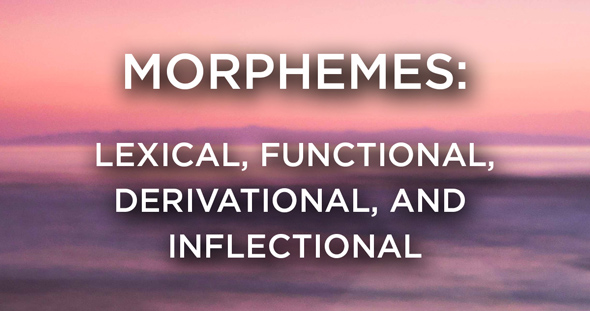E
Lexical, Functional, Derivational, and Inflectional Morphemes
In our last post on Free vs. Bound Morphemes, we looked at the two main categories of morphemes, free and bound morphemes. Today, we will be looking at some more specific categories of morphemes.
To review, let me go over what a morpheme is again. Morphemes are the smallest units of meaning or grammatical function within a language. The two main categories, free and bound morphemes, each have two sub-categories under them:
Categories of free morphemes
Lexical morphemes
Morphemes that carry the content or meaning of the messages that we are conveying. In order to identify a lexical morpheme, ask yourself this: “If this morpheme was deleted, would I not be able to understand the main message of this sentence?” If the answer is yes, then you have a lexical morpheme.
Examples of lexical morphemes: follow, type, look, yellow, act, pick, strange
Functional morphemes
Morphemes that do not carry the content of a message, but rather help the grammar of the sentence function. These free morphemes can be identified by asking yourself this question: “If this morpheme was deleted, would I still be able to understand the main message of this sentence?” If the answer is yes, then you have a functional morpheme.
Examples of functional morphemes: but, when, near, above, in, the, that, them, if
Categories of bound morphemes
Derivational morphemes
Morphemes that transform words into different grammatical categories from the root word (a free morpheme). These morphemes transform words into different parts of speech. In order to identify a derivational morpheme, ask yourself this question: “If this morpheme was added, would it change the part of speech of this word?” If the answer is yes, then you have a derivational morpheme.
Examples of derivational morphemes: -ful, -ness, -less, -ly, -y, -ish, -ment
care = noun
care + ful = adjective
Kind = adjective
kind + ness = noun
Inflectional morphemes
Morphemes that indicate aspects of the grammatical function of a word, such as changing a word into a plural or possessive form. In order to identify an inflectional morpheme, ask yourself this: “By adding this bound morpheme, does it keep the word in the same grammatical category, but change some aspect of it?” If the answer is yes, then you have an inflectional morpheme. English only has 8 inflectional morphemes.
Examples of inflectional morphemes:
Nouns: -‘s, ‘s
Verbs: -s, -ing, -ed, -en
Adjectives: -er, -est
Are you ready to identify these different sub-categories of morphemes? See if you can test your knowledge by reading the sentence below and labeling the morphemes into these 4 sub-categories. The answer is written at the bottom of this post.
Try it!
The teacher’s frankness shocked the boy’s parents.
Now, see if you can determine what type of morphemes are in the sentence. There are 13 total morphemes. When you’re ready to check your answer, read the correct response below.
Answer:
The – functional
teach – lexical
-er – derivational
‘s – inflectional
frank – lexical
-ness – derivational
shock – lexical
-ed – inflectional
the – functional
boy – lexical
‘s – inflectional
parent – lexical
-s – inflectional
Want to improve your English pronunciation? Join my Clear English Pronunciation video course to speak English clearly. It’s 4 hours of pronunciation practice all the sounds of English. You get lifetime access, and can watch any time from any device. Click here to get started.




The wonderful definition of functional morpheme I got here.
Thanks for sharing this.
Glad to hear it!
Thank you! Your article is very useful.
I first have to say THANKS, it really helped me a lot because I had serious difficult on understanding these Morpheme
So happy to help!
Thank you! Your article is very useful.
Thank you! This was very helpful.
I have questions though:
Are subject pronouns considered lexical or functional morphemes?
I’d say functional, but I’ve read conflicting reports.
What about auxiliary and modal verbs?
They fall under the functional category too, right?
Thank you in advance!